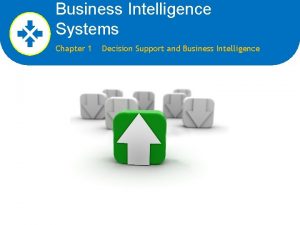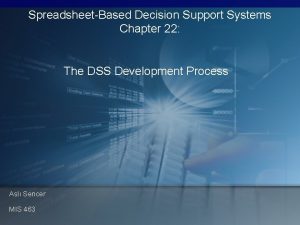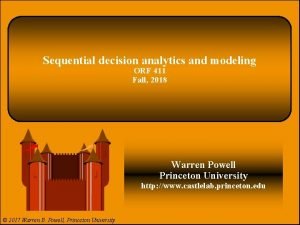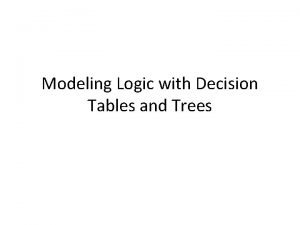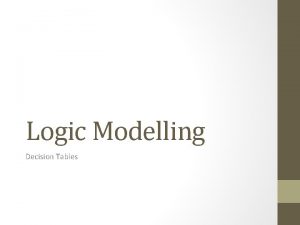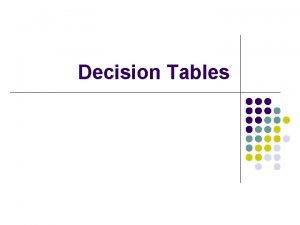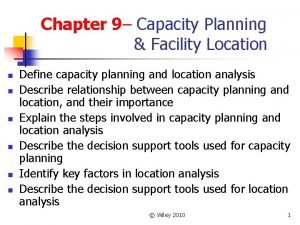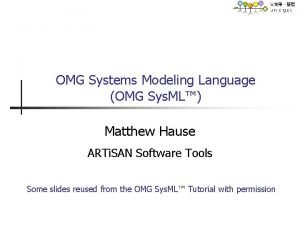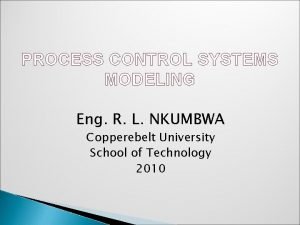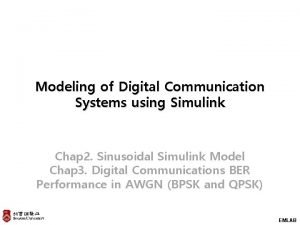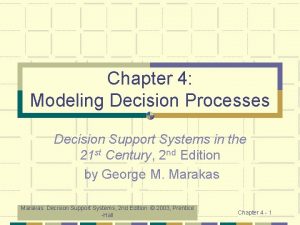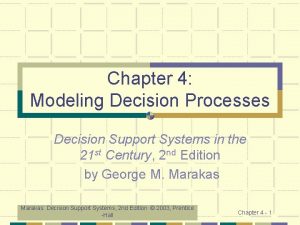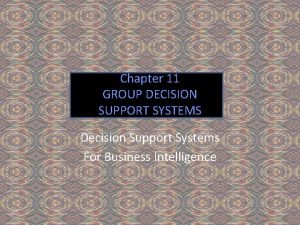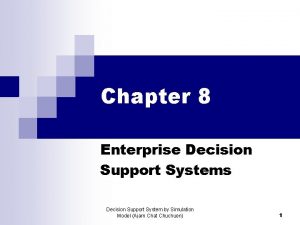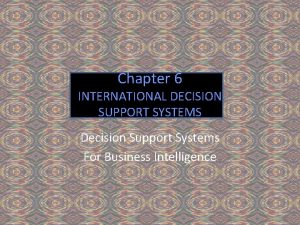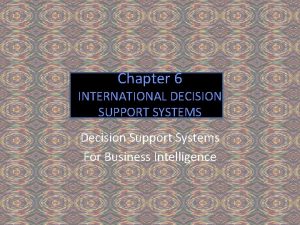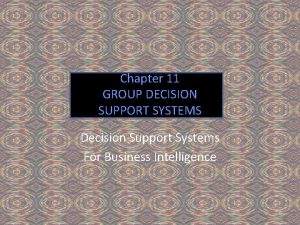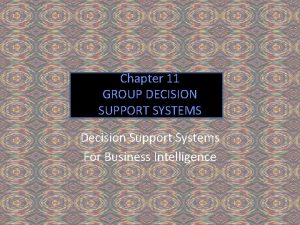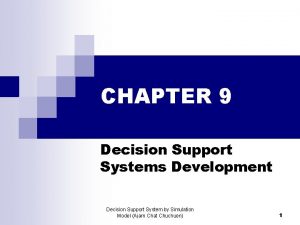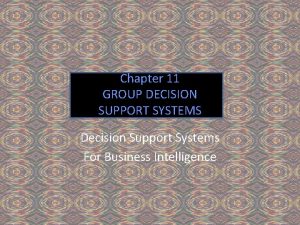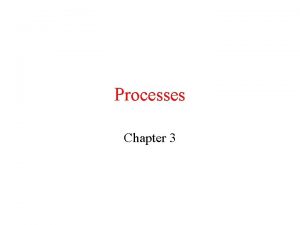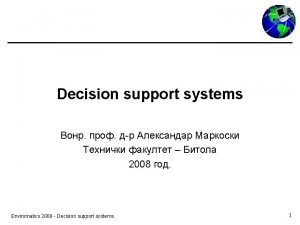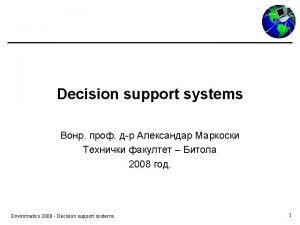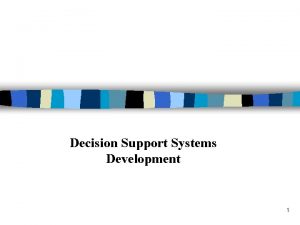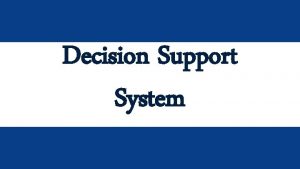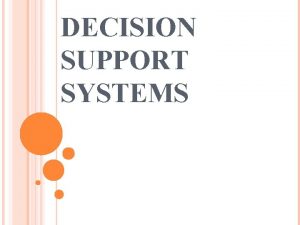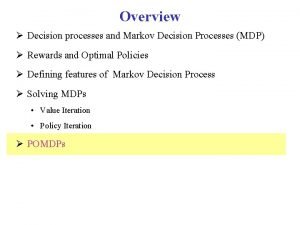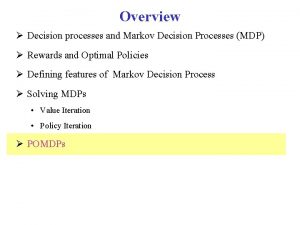Chapter 4 Modeling Decision Processes Decision Support Systems



















- Slides: 19

Chapter 4: Modeling Decision Processes Decision Support Systems in the 21 st Century, 2 nd Edition by George M. Marakas: Decision Support Systems, 2 nd Edition © 2003, Prentice -Hall Chapter 4 - 1

4 -1: Defining the Problem and Its Structure A fully formed problem statement contains three key components: • The current state of affairs • The desired state of affairs • A statement of the central objective(s) that distinguish the two Marakas: Decision Support Systems, 2 nd Edition © 2003, Prentice-Hall 2

Problem Definition Errors Failing to identify and define the problem fully may result in a great solution that does not solve the right problem A common error: premature focus on the set of solutions rather than the problem itself The decision maker may be left with a solution looking for a problem to solve Marakas: Decision Support Systems, 2 nd Edition © 2003, Prentice-Hall 3

Problem Scope The problem may be worth solving but the scope is beyond the available resources or time constraints In such cases, the scope must be reduced to a focus that allows a solution One method to limit the scope is to identify its breadth by asking questions about people involved, cost and magnitude Marakas: Decision Support Systems, 2 nd Edition © 2003, Prentice-Hall 4

Problem Structure Design of problem structure is similar to design of many other entities l What is the final appearance? l What are the elemental details? l What are the relationships between those elements? Regardless of context, a problem structure can be described in terms of choices, uncertainties and objectives Marakas: Decision Support Systems, 2 nd Edition © 2003, Prentice-Hall 5

Problem Structure (cont. ) Choices: there always at least two alternatives (one is “do nothing”) Uncertainties: situations beyond the direct control of the decision maker; their individual probability of occurrence is only estimable within a certain range Objectives: methods of establishing the criteria used to measure the value of the outcome Marakas: Decision Support Systems, 2 nd Edition © 2003, Prentice-Hall 6

Structuring Tools Influence diagram: a simple method of graphing the components of a decision and linking them to show the relationships between them Uncertainty Decision Marakas: Decision Support Systems, 2 nd Edition © 2003, Prentice-Hall Objective 7

Structuring Tools (cont. ) Decision tree: another diagram that models choices and uncertainties and can be extended to include multiple, sequential decisions Uncertainty Decision Marakas: Decision Support Systems, 2 nd Edition © 2003, Prentice-Hall 8

Common Decision Structures Basic Risky Decision: decision maker takes a choice in the face of uncertainty. Success is a function of the choice and outcome. Certainty: a multiple-objective decision with little risk. Success is a function of the tradeoff between objectives. Sequential: several risky decisions over time. Earlier outcomes may affect later choices. Marakas: Decision Support Systems, 2 nd Edition © 2003, Prentice-Hall 9

4 -2: Decision Models Decision models can be classified in a number of ways: l Is time a factor? Models that do not include time are “static” versus “dynamic” l What is the technique’s mathematical focus? Some abstract model types are deterministic, stochastic, simulation and domain specific Marakas: Decision Support Systems, 2 nd Edition © 2003, Prentice-Hall 10

Model Classification Examples Deterministic: linear programming, production planning Stochastic: queuing theory, linear regression analysis Simulation: production modeling, transportation analysis Domain-specific: EOQ, technology diffusion, meteorological models Marakas: Decision Support Systems, 2 nd Edition © 2003, Prentice-Hall 11

Conceptual Models A formal mathematical approach is not always appropriate Conceptual models are formulated under the notion that even though all problems are unique, no problem is completely new Decision makers can recall and combine a variety of past experiences to create an accurate model of the current situation Marakas: Decision Support Systems, 2 nd Edition © 2003, Prentice-Hall 12

4 -3: Types of Probability Three requirements of probability: 1. All probabilities are in the range 0 to 1 2. The probabilities of all outcomes of an event must add up to the probability of their union 3. The total probability of a complete set of outcomes must equal 1 Marakas: Decision Support Systems, 2 nd Edition © 2003, Prentice-Hall 13

How Are Probabilities Generated? Long-run frequency: with enough “history”, you can estimate an event’s probability by its relative frequency Subjective: probability represents an individual’s “degree of belief” that an event will occur Logic: a probability may be derivable, but its accuracy may not be acceptable Marakas: Decision Support Systems, 2 nd Edition © 2003, Prentice-Hall 14

4 -4: Techniques for Forecasting Probabilities Direct probability forecasting — an expert is simply asked to estimate the chance that an outcome will occur Odds forecasting — a series of bets are proposed to determine how strongly the bettor feels an event will occur Comparison forecasting — similar to odds forecasting except that one game has known probabilities Marakas: Decision Support Systems, 2 nd Edition © 2003, Prentice-Hall 15

Decomposing Complex Probabilities for complex events may be more easily generated by using conditional probabilities within subsets of the events For example, it may be easier to forecast sales of a weather-related product by forecasting sales under good weather, then bad weather and then considering the probability of bad weather Marakas: Decision Support Systems, 2 nd Edition © 2003, Prentice-Hall 16

4 -5: Calibration and Sensitivity A decisionmaker is said to be well calibrated if his probability forecasts are correct at about the same rate as his confidence in them (9 out of 10 times his 90% confidence intervals should be correct). Calibration requires years of experience and feedback to develop. Most of us are too optimistic and our intervals are too tight. Marakas: Decision Support Systems, 2 nd Edition © 2003, Prentice-Hall 17

Sensitivity Analysis A method for testing the degree to which a set of assumptions affects the results from a model. If a small change in the value of a variable yields a measurable change in output, that variable is said to be highly sensitive. Variables that are not sensitive may be treated as fixed, reducing the model’s complexity. Marakas: Decision Support Systems, 2 nd Edition © 2003, Prentice-Hall 18

Value Analysis We always need to be concerned that enough reliable information is available to make a successful decision. We can determine how much we are willing to pay for better info by computing its expected value. This involves a comparison of the expected return with the info to the expected return without the info. Marakas: Decision Support Systems, 2 nd Edition © 2003, Prentice-Hall 19
 Decision support systems and intelligent systems
Decision support systems and intelligent systems Helen erickson biography
Helen erickson biography Dimensional modeling vs relational modeling
Dimensional modeling vs relational modeling Decision support and business intelligence systems
Decision support and business intelligence systems Developing spreadsheet-based decision support systems
Developing spreadsheet-based decision support systems What is decision support system in business intelligence
What is decision support system in business intelligence Decision support system vs expert system
Decision support system vs expert system Concurrent in os
Concurrent in os No decision snap decision responsible decision
No decision snap decision responsible decision Slidetodoc.com
Slidetodoc.com Sequential decision analytics
Sequential decision analytics Modeling logic with decision tables
Modeling logic with decision tables Modeling logic with decision tables
Modeling logic with decision tables Decision table شرح
Decision table شرح Explain the decision tree modeling for capacity expansion
Explain the decision tree modeling for capacity expansion Omg systems modeling language
Omg systems modeling language Mathematical modeling of mechanical systems
Mathematical modeling of mechanical systems Control systems modeling
Control systems modeling Modeling of digital communication systems using simulink
Modeling of digital communication systems using simulink Modeling of digital communication systems using simulink
Modeling of digital communication systems using simulink



